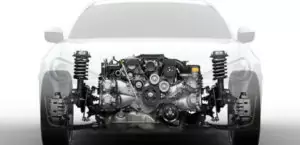The company assembled the 2.0-liter turbo engine Audi CAEA or A5 2.0 TFSI from 2008 to 2014 and put on American modifications of such well-known models as the A4, A5 and the Q5 crossover. The motor met the environmental standards ULEV 2, its European version under Euro 5 was called CDNB.
The EA888 gen2 series includes: CDAA, CDAB, CDHA, CDHB, CCZA, CCZB, CCZC, CCZD, CDNB, CDNC, CAEA, CAEB.
Specifications
| Production years | 2008-2014 |
| Displacement, cc | 1984 |
| Fuel system | direct injection |
| Power output, hp | 180 |
| Torque output, Nm | 320 |
| Cylinder block | cast iron R4 |
| Block head | aluminum 16v |
| Cylinder bore, mm | 82.5 |
| Piston stroke, mm | 92.8 |
| Compression ratio | 9.6 |
| Features | DOHC, AVS |
| Hydraulic lifters | yes |
| Timing drive | chain |
| Phase regulator | on the intake shaft |
| Turbocharging | KKK K03 |
| Recommended engine oil | 5W-30 |
| Engine oil capacity, liter | 4.6 |
| Fuel type | petrol |
| Euro standards | ULEV 2 |
| Fuel consumption, L/100 km (for Audi A5 2011) — city — highway — combined |
8.4 5.4 6.5 |
| Engine lifespan, km | ~250 000 |
| Weight, kg | 142 |
The engine was installed on:
- Audi A4 B8 (8K) in 2008 – 2011;
- Audi A5 1 (8T) in 2008 – 2011;
- Audi Q5 1 (8R) in 2009 – 2014.
Disadvantages of the Audi CAEA engine
- This unit is known for high oil consumption due to a defective piston group;
- You can save the engine from the oil burner by replacing pistons, for example, with forged ones;
- Also, oil waste leads to the rapid formation of carbon deposits and floating revolutions;
- The timing chain has a modest resource here, sometimes it stretches to 100,000 km;
- Other weak points of the engine include a water pump, ignition coils, injection pump.






